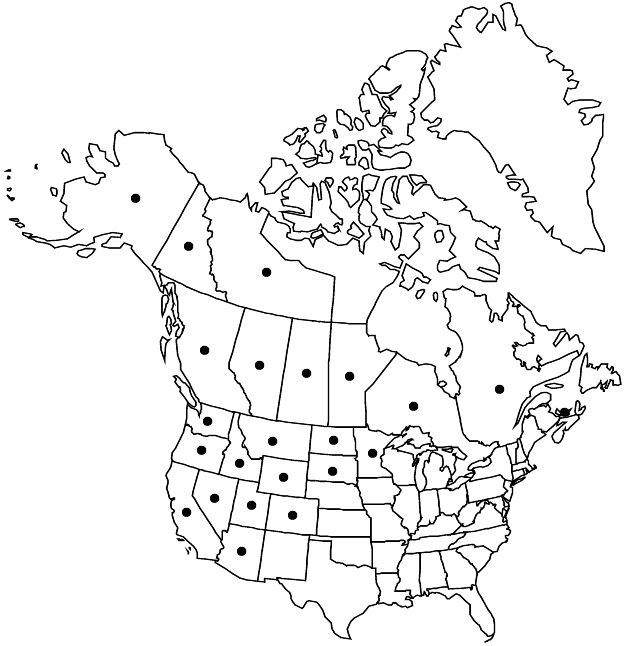Difference between revisions of "Potentilla gracilis var. fastigiata"
Proc. Amer. Acad. Arts 8: 557. 1873.
FNA>Volume Importer |
imported>Volume Importer |
||
| Line 123: | Line 123: | ||
|publication year=1873 | |publication year=1873 | ||
|special status=Endemic | |special status=Endemic | ||
| − | |source xml=https:// | + | |source xml=https://bibilujan@bitbucket.org/aafc-mbb/fna-data-curation.git/src/bb6b7e3a7de7d3b7888a1ad48c7fd8f5c722d8d6/coarse_grained_fna_xml/V9/V9_226.xml |
|subfamily=Rosaceae subfam. Rosoideae | |subfamily=Rosaceae subfam. Rosoideae | ||
|tribe=Rosaceae tribe Potentilleae | |tribe=Rosaceae tribe Potentilleae | ||
Revision as of 00:27, 28 May 2020
Stems (0.5–)1.5–7(–9) dm. Basal leaves: petiole (2–)3–20(–45) cm, long hairs common to dense, appressed to spreading, 0.5–2(–3) mm, stiff, crisped hairs usually absent, sometimes sparse to common, cottony hairs absent, glands absent or sparse; leaflets 5–7(–9), separate to ± overlapping, largest oblanceolate to elliptic or narrowly obovate, (1.5–)2–7(–10) × (0.7–)1.5–3.5 cm, margins flat to slightly revolute, distal (2/3–)3/4 to nearly whole length ± evenly incised 1/4–1/2 to midvein, undivided medial blade 6–20 mm wide, teeth 5–9(–11) per side, usually not secondarily toothed, narrowly lanceolate to ovate, 2–10 mm, surfaces ± similar to ± dissimilar, abaxial pale green to greenish gray, long hairs sparse to abundant (mostly on veins), crisped hairs absent or sparse to abundant, cottony hairs usually absent, glands absent or sparse, rarely common, adaxial green to grayish green, long hairs sparse to common, sometimes absent, crisped and cottony hairs absent, glands absent or sparse, rarely common. Flowers: epicalyx bractlets 2–6.5(–7) × 0.5–1.5(–2.5) mm; hypanthium 4–6 mm diam.; petals (3–)4–8(–10) × (3–)4–10(–12) mm; carpels (15–)30–50, styles 1.5–2.5(–3) mm. Achenes 1.4–1.8 mm.
Phenology: Flowering summer.
Habitat: Vernally moist to dry meadows or gravelly flats and slopes, in grassland and sagebrush communities, oak, aspen, or conifer woodlands
Elevation: (10–)100–3500 m
Distribution

Alta., B.C., Man., N.W.T., Ont., P.E.I., Que., Sask., Yukon, Alaska, Ariz., Calif., Colo., Idaho, Minn., Mont., Nev., N.Dak., Oreg., S.Dak., Utah, Wash., Wyo.
Discussion
Variety fastigiata was commonly known as var. nuttallii until N. H. Holmgren (1997b) noted that var. fastigiata had priority at varietal rank, due to the publication of Potentilla holopetala Turczaninow var. fastigiata (Nuttall) Lehmann. As used here, the variety encompasses most collections of P. gracilis with moderately and evenly toothed leaflets that have at most somewhat dissimilar leaflet surfaces that usually lack cottony hairs. As such, the variety is essentially the catch-all category for most variation within P. gracilis that is not assigned elsewhere.
Within this broad circumscription are at least three candidates for taxonomic recognition. First is var. fastigiata in the narrow sense, consisting of relatively large, hairy plants found throughout the range given above. The hallii phase, found mostly in the mountains of California, is shorter on average, and leaflets tend to be broader, less hairy, and less deeply incised. Glabrate populations that are common from eastern Oregon to the northern Rocky Mountains, some possibly indicating introgression from Potentilla glaucophylla, represent the nuttallii or glabrata phase.
Occurrences in Quebec and Prince Edward Island, and at least some other occurrences in eastern provinces and states, are most likely introduced. Eastern populations of var. fastigiata in general tend to be relatively hairy and to intergrade with Potentilla pulcherrima.
Selected References
None.